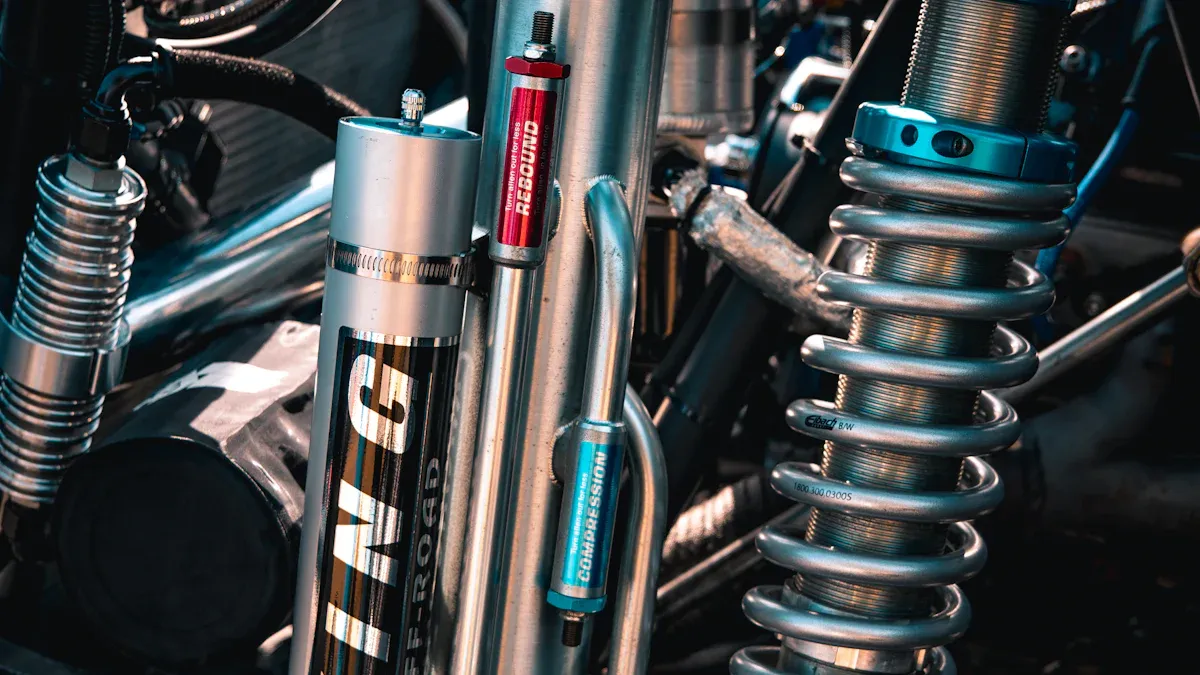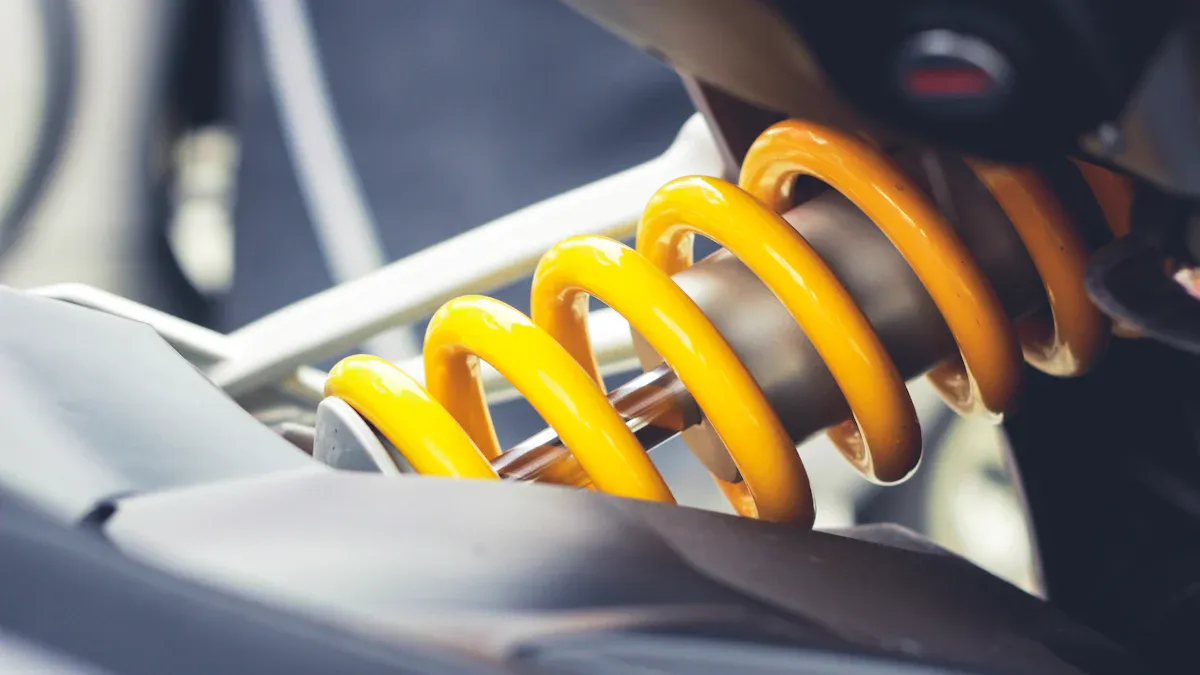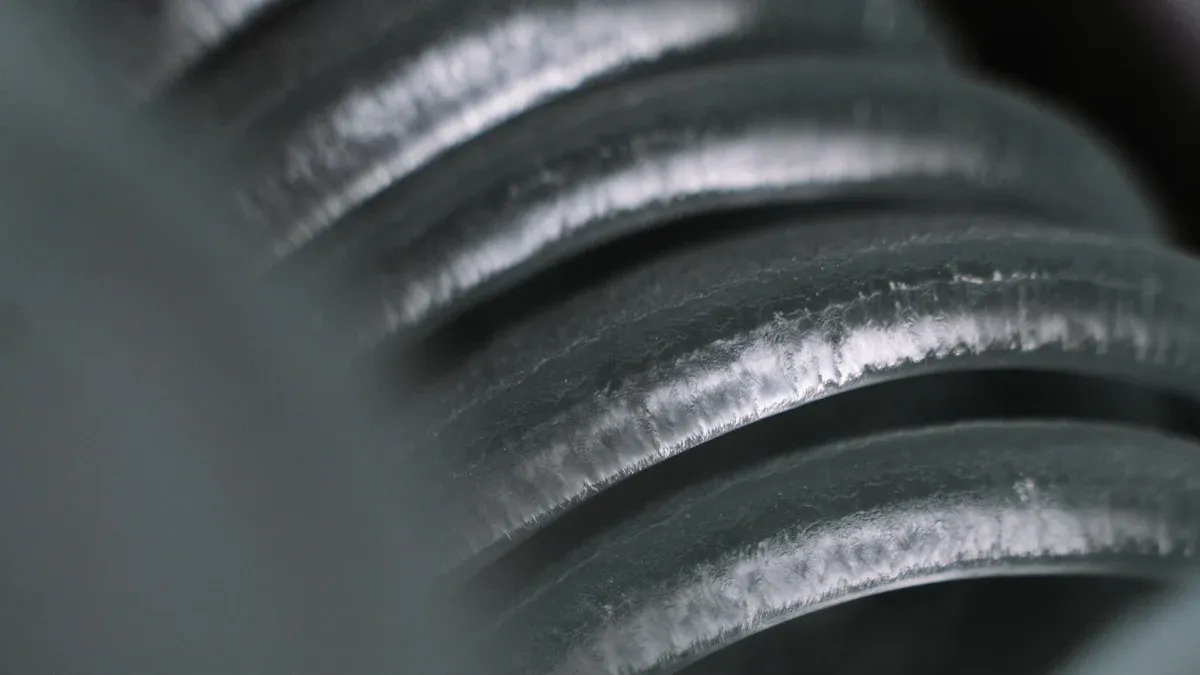Simplify Spring Coil Assembly with PET Heat Shrink Tubing

PET heat shrink tubing for spring coils has revolutionized medical device manufacturing. Its ability to provide a precise and durable fit eliminates the need for adhesives, streamlining the assembly process. The market for PET heat shrink tubing continues to grow, with the healthcare segment projected to capture up to 20% of the market share by the end of the decade. This growth is driven by advancements in medical technology and the increasing demand for reliable solutions in an aging population. PET’s flexibility and wear resistance make it an ideal choice for intricate medical applications, ensuring both functionality and longevity.
Key Takeaways
PET heat shrink tubing makes spring coil assembly easier. It fits tightly without glue, saving time and money.
This material is strong and resists wear, lasting long in tough medical uses.
Preparing well and using heat correctly are key for good results. This ensures a snug fit and avoids problems.
Picking the right size, thickness, and shrink amount is important. It helps match medical devices and follow industry rules.
Working with reliable suppliers ensures good quality and safety. This is crucial for making safe and dependable medical devices.
Understanding PET Heat Shrink Tubing
Key properties of PET material
Polyethylene terephthalate (PET) is a versatile material widely used in medical device material technology due to its exceptional properties. It offers high tensile strength, excellent clarity, and resistance to wear and tear, making it ideal for demanding applications. PET also demonstrates remarkable thermal stability, ensuring consistent performance under varying temperatures.
Studies have validated PET's durability in medical environments. For instance:
A 2023 study in the Journal of Medical Materials Research revealed that unmodified PET retained significant tensile strength even after 50 hydrogen peroxide sterilization cycles, with only a 12% reduction.
Tubing made from PET maintains dimensional stability and insulation properties during prolonged sterilization testing, which often spans 12–18 months.
These attributes make PET heat shrink tubing a reliable choice for high-performance medical devices, including variable-stiffness catheters and spring coils.
How heat shrink tubing functions
Heat shrink tubing operates by shrinking when exposed to heat, conforming tightly to the shape of the underlying object. This process ensures a secure fit, providing insulation, protection, and structural integrity. Testing methods, such as unrestricted shrinkage, confirm the tubing's ability to perform reliably in real-world applications.
Key functional characteristics include:
Tensile strength
Heat resistance
Sealing efficiency
Clarity stability
These features enable PET heat shrink tubing to withstand extreme conditions, ensuring durability and performance in critical applications like aerospace and medical fields.
Applications in medical devices, including catheters and spring coils
PET heat shrink tubing is integral to various medical device applications. Its flexibility and precision make it suitable for intricate designs, such as spring coils and catheters. For example:
Application Area | Challenges Faced | Performance Requirements |
|---|---|---|
Spring Coils | Complex structure design leading to potential ruptures of thin-walled tubing | 1:1 tactile feedback, smooth tracking, high flexibility |
Catheters | Bending or wrinkling during assembly affecting efficiency | Effective delivery and sealing capabilities |
By addressing these challenges, PET heat shrink tubing enhances the functionality and reliability of medical devices, ensuring optimal performance in critical healthcare settings.
Step-by-Step Guide to Using PET Heat Shrink Tubing for Spring Coils

Preparing the spring coil and selecting the right tubing
Proper preparation is essential for achieving optimal results when working with PET heat shrink tubing. Begin by selecting the correct tubing size and length. Measure the diameter of the spring coil system and ensure the tubing’s recovered diameter is slightly smaller to guarantee a snug fit. Cleaning the spring coil thoroughly is equally important. Remove any contaminants, such as dust or grease, that could interfere with adhesion or insulation.
Once the surface is clean, inspect the tubing for any defects. Engineering tests recommend using medical-grade tubing that meets compliance standards for durability and performance. Following these preparation protocols ensures the tubing will perform reliably in demanding applications.
Applying heat for a secure fit
Applying heat to PET heat shrink tubing requires precision and control. Use a heat gun or an oven to evenly distribute heat across the tubing. The recovery temperature, approximately 110°C, is critical for achieving a secure fit. Monitoring the temperature closely prevents issues like gaps or damage to the tubing. Even heat application ensures the tubing conforms tightly to the spring coil without wrinkles or bubbles.
Controlled experiments highlight the importance of uniform heating. Uneven application can compromise the tubing’s structural integrity and lead to premature failure. For best results, rotate the spring coil during heating to achieve a professional finish.
Key Guidelines for Heat Application | Importance |
|---|---|
Maintain a recovery temperature of 110°C | Ensures proper shrinkage and a secure fit. |
Apply heat evenly | Prevents defects such as gaps or uneven shrinkage. |
Monitor closely | Avoids overheating, which can damage the tubing or underlying components. |
Ensuring proper insulation and functionality
After the tubing has been applied, inspect the assembly to confirm proper insulation and functionality. Performance metrics, such as dielectric strength and sealing efficiency, are critical for ensuring the tubing meets medical-grade standards. Check for a tight fit around the spring coil system and address any visible defects, such as cracks or uneven shrinkage.
Insulation tests validate the tubing’s ability to maintain clarity, resist corrosion, and withstand environmental factors. These properties ensure the tubing provides long-term protection and enhances the reliability of the spring coil system. By following these steps, manufacturers can optimize the performance and durability of their medical devices.
Insulation Property | Description |
|---|---|
Dielectric strength | Measures the tubing’s ability to insulate against electrical currents. |
Sealing efficiency | Evaluates how well the tubing protects against environmental factors. |
Heat resistance | Ensures the tubing can withstand high temperatures without degradation. |
Low-temperature flexibility | Confirms the tubing remains functional in cold environments. |
Benefits of PET Heat Shrink Tubing for Spring Coil Assembly

Enhanced durability and wear resistance
PET heat shrink tubing offers exceptional durability and wear resistance, making it a reliable choice for spring coil assembly in medical devices. Its high tensile strength, measured at over 20,000 psi, ensures that the tubing can withstand significant mechanical stress without compromising its structural integrity. This strength is complemented by its ability to maintain insulation properties, even under demanding conditions. For instance, AccuPath® PET heat shrink tubing features ultra-thin walls of just 0.00015 inches, yet it provides high insulation of 4000V/mil, ensuring both durability and electrical safety.
The tubing's resilience is another critical factor. AccShrink® PET tubing demonstrates superior recovery after compression, rebounding to its original tubular shape. This property is essential during assembly, where the tubing must endure mechanical manipulation without permanent deformation. The process capability index (Cpk) of PET heat shrink tubing exceeds 1.33, reflecting its consistent quality and adherence to stringent manufacturing standards. These attributes collectively enhance the longevity and reliability of spring coil systems in medical devices.
Flexibility for intricate medical device designs
The flexibility of PET heat shrink tubing makes it ideal for intricate medical device designs, such as minimally invasive surgical tools and catheter systems. Its ability to conform to complex geometries addresses the challenges manufacturers face in creating precise and reliable components. This tubing supports advanced designs by offering biocompatibility, chemical resistance, and sterilizability, which are critical for medical applications.
For example, catheter manufacturers rely on ultra-thin PET tubing for electrical insulation and protection against bodily fluids. Its innovative technology ensures that even the most delicate designs maintain their functionality and integrity. The demand for PET heat shrink tubing for spring coils continues to grow as it enables the production of sophisticated medical devices that meet the highest performance standards.
Cost-effectiveness and time savings in manufacturing
PET heat shrink tubing streamlines the manufacturing process, reducing costs and saving time. Unlike adhesive-based assembly methods, which require additional materials and curing time, heat shrink tubing simplifies the process by providing a secure fit through heat application. This eliminates the need for adhesives, reducing material costs and minimizing production steps.
The tubing's high shrink ratio, typically 2:1 or greater, ensures a snug fit over spring coils, reducing the likelihood of rework or defects. Its consistent quality and performance further contribute to manufacturing efficiency. By adopting PET heat shrink tubing, manufacturers can achieve faster production cycles, lower operational costs, and improved product reliability, making it a cost-effective solution for medical device assembly.
PET Heat Shrink Tubing vs. Alternative Methods
Comparison with silicone tubing
Silicone tubing has long been a staple in medical device manufacturing due to its flexibility and biocompatibility. However, it falls short in areas where precision and durability are critical. Silicone tubing often lacks the tensile strength and wear resistance required for intricate designs like spring coils. Its susceptibility to tearing under mechanical stress makes it less reliable for applications demanding long-term performance.
In contrast, PET heat shrink tubing offers superior durability and structural integrity. Its high tensile strength and resistance to wear make it ideal for demanding environments. Additionally, PET tubing provides a tighter fit and better insulation, ensuring consistent performance in medical devices. While silicone tubing may suffice for simpler applications, PET tubing excels in complex, high-performance designs.
Adhesive-based assembly vs. heat shrink tubing
Adhesive-based assembly methods involve multiple steps, including applying adhesives, curing, and cleaning excess material. This process increases production time and costs while introducing potential points of failure. Adhesives can degrade over time, compromising the device's reliability.
PET heat shrink tubing eliminates the need for adhesives by providing a secure fit through heat application. This streamlined process reduces assembly time and minimizes material waste. The tubing's consistent quality ensures fewer defects, enhancing overall manufacturing efficiency. For medical devices, where precision and reliability are paramount, PET tubing offers a more effective and economical solution.
Why PET tubing is ideal for medical applications
PET tubing meets the stringent requirements of modern medical devices. It is widely used in drug delivery systems like insulin pumps and wearable injectors, where its resistance to pharmaceuticals ensures consistent dosing. In robotic surgical tools, PET tubing insulates sensors, supporting the shift toward disposable components to prevent cross-contamination.
Regulatory standards, such as ISO 17665-1:2023, require materials to withstand high-temperature sterilization. PET tubing fulfills this requirement without degradation, making it a reliable choice for sterilizable devices. Recent innovations in PET blends have further improved its fatigue resistance, enabling it to endure multiple sterilization cycles. These attributes solidify PET tubing's position as an optimal solution for medical applications.
Choosing the Right PET Heat Shrink Tubing for Medical Devices
Factors to consider, such as size, thickness, and shrink ratio
Selecting the appropriate PET heat shrink tubing requires careful evaluation of key factors like size, thickness, and shrink ratio. These parameters directly influence the tubing's performance and compatibility with medical devices. For instance, the tubing's diameter must align with the spring coil's dimensions to ensure a snug fit. A shrink ratio of 2:1 or higher is often preferred for medical applications, as it provides reliable coverage and insulation.
Thickness plays a critical role in determining the tubing's durability and flexibility. Medical devices, such as catheters and spring coils, demand ultra-thin tubing—typically below 0.1mm—to minimize bulk and maintain precision. The following table highlights how these factors vary across industries:
Application Area | Key Factors | Thickness Requirement | Growth Rate |
|---|---|---|---|
Consumer Electronics | Miniaturization, high reliability, insulation | Under 0.2mm | 12% CAGR by 2025 |
Electric Vehicle Battery Systems | Energy density, thermal management | Under 0.2mm | 18% CAGR through 2027 |
Medical Devices | Hermetic sealing, minimal bulk | Below 0.1mm | $12.3 billion by 2028 |
Renewable Energy Infrastructure | UV resistance, temperature fluctuations | Ultra-thin variants | 22% yearly growth |
By prioritizing these specifications, manufacturers can ensure optimal performance and compliance with industry standards.
Importance of medical-grade compliance
Medical-grade compliance is essential for PET heat shrink tubing used in healthcare applications. Regulatory frameworks, such as the FDA Quality System Regulation and ISO 10993, mandate rigorous testing for biocompatibility, sterilization compatibility, and material safety. These standards ensure that the tubing meets the stringent requirements of medical environments.
For example, ISO 10993 testing evaluates cytotoxicity and sterilization compatibility, reducing lead times for FDA submissions. Similarly, CE marking is crucial for Class IIa and IIb devices, facilitating procurement contracts in hospitals. The table below outlines key regulatory frameworks and their impact on PET tubing:
Regulatory Framework | Key Requirements | Impact on PET Tubing |
|---|---|---|
FDA Quality System Regulation | Comprehensive documentation of material sourcing and manufacturing processes | Ensures safety and performance for medical applications |
EU Medical Device Regulation | Expanded clinical evaluation requirements | Increased market access barriers for non-compliant suppliers |
ISO 10993 Biocompatibility Testing | Testing for cytotoxicity and sterilization compatibility | Reduces lead times for FDA submissions |
CE Marking | Technical documentation for Class IIa/IIb devices | Essential for procurement contracts in hospitals |
Adhering to these standards not only ensures patient safety but also enhances market access and device reliability.
Partnering with trusted suppliers for quality assurance
Collaborating with reliable suppliers is critical for maintaining the quality and consistency of PET heat shrink tubing. Trusted suppliers adhere to stringent regulatory certifications, such as FDA and CE, which establish competitive barriers and build customer trust. They also mitigate risks associated with supply chain disruptions and non-compliance.
For instance, over 80% of ultra-pure terephthalic acid, a key component of PET, is sourced from South Korea, highlighting the importance of supplier reliability. Additionally, the EU’s revised Packaging and Packaging Waste Regulation mandates 45% post-consumer recycled content by 2025, impacting production timelines. Partnering with suppliers who meet these requirements ensures uninterrupted production and compliance with evolving regulations.
Evidence Type | Description |
|---|---|
Regulatory Certifications | FDA and CE certifications create competitive barriers, influencing market access and customer trust for suppliers of PET heat shrink tubing. |
Supplier Dependency Risks | Over 80% of ultra-pure terephthalic acid for Japanese manufacturers comes from South Korea, highlighting risks from regional supply disruptions. |
Environmental Compliance | The EU’s revised Packaging and Packaging Waste Regulation mandates 45% post-consumer recycled content by June 2025, impacting production timelines and supplier reliability. |
By choosing reputable suppliers, manufacturers can safeguard their operations, reduce compliance risks, and maintain the high standards required for medical devices.
PET heat shrink tubing plays a pivotal role in simplifying spring coil assembly for medical devices. Its precision and durability ensure reliable performance, while its cost efficiency streamlines manufacturing processes.
By leveraging the unique properties of PET tubing, manufacturers can enhance device functionality and meet stringent industry standards.
Explore the wide range of PET heat shrink tubing options available today. Elevate your medical device production and deliver superior results with this innovative solution.
FAQ
What is the shrink ratio of PET heat shrink tubing, and why is it important?
The shrink ratio refers to how much the tubing reduces in size when heat is applied. A 2:1 ratio means the tubing shrinks to half its original diameter. This ensures a snug fit, providing optimal insulation and protection for medical devices like spring coils.
Can PET heat shrink tubing withstand sterilization processes?
Yes, PET heat shrink tubing is designed to endure rigorous sterilization methods, including autoclaving and hydrogen peroxide cycles. Its thermal stability and chemical resistance ensure it maintains performance and integrity, even after repeated sterilizations, making it ideal for medical applications.
How does PET heat shrink tubing compare to other materials in terms of durability?
PET tubing outperforms materials like silicone in durability. It offers higher tensile strength, wear resistance, and structural integrity. These properties make it suitable for demanding applications, such as spring coil assembly, where long-term reliability is critical.
Is PET heat shrink tubing biocompatible?
Yes, PET heat shrink tubing meets biocompatibility standards, such as ISO 10993. It is safe for use in medical devices that come into contact with human tissue or fluids. This compliance ensures patient safety and device reliability in healthcare settings.
What factors should manufacturers consider when selecting PET heat shrink tubing?
Manufacturers should evaluate tubing size, thickness, and shrink ratio. They must also ensure compliance with medical-grade standards, such as FDA and ISO certifications. Partnering with trusted suppliers guarantees consistent quality and adherence to regulatory requirements.
Tip: Always verify the tubing's specifications against the device's design to ensure compatibility and performance.
See Also
Understanding PET Heat Shrink Tubing for Electronic Applications
Applications of Heat Shrink Tubing for Electrical Wire Insulation
A Comprehensive Guide to Selecting Heat Shrink Tubing Sizes
Key Advice for Effectively Utilizing FEP Heat Shrink Tubing
Selecting Optimal Ultra-Thin PET Heat Shrink Tubing for Projects

